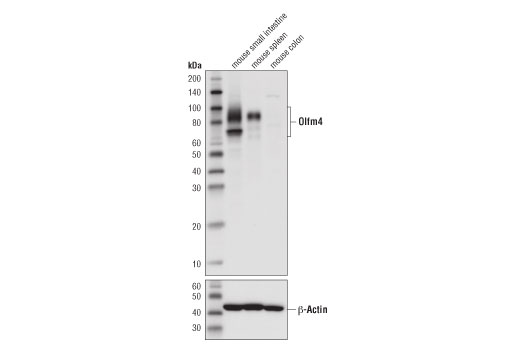
 DeepBio得分:
DeepBio得分:
 DeepBio得分
是基于文獻(xiàn)引用次數(shù),影響因子,文獻(xiàn)新近度等因素計(jì)算的客觀產(chǎn)品評級,得分越高表明該產(chǎn)品經(jīng)過越可靠的實(shí)驗(yàn)驗(yàn)證,質(zhì)量可信度越高
DeepBio得分
是基于文獻(xiàn)引用次數(shù),影響因子,文獻(xiàn)新近度等因素計(jì)算的客觀產(chǎn)品評級,得分越高表明該產(chǎn)品經(jīng)過越可靠的實(shí)驗(yàn)驗(yàn)證,質(zhì)量可信度越高
|
2家供應(yīng)商在售
|
||||||
| 商品名稱 | 規(guī)格 | 代理級別 | 價(jià)格 | 運(yùn)費(fèi) | 供應(yīng)商 | 購買 |
|
Olfm4 (D6Y5A) XP ? Rabbit mAb (Mouse Specific)
交貨周期:現(xiàn)貨
|
20 μl | 經(jīng)銷 |
登錄可見
|
- |
北京敏泰元科技有限公司 |
庫存:20
|
|
CST 39141T Olfm4(D6Y5A)XP Rabbit mAb(Mouse Specific)
交貨周期:部分現(xiàn)貨,期貨3-4周左右,優(yōu)質(zhì)售后
|
20μl | 經(jīng)銷 |
登錄可見
|
- |
上海優(yōu)寧維生物科技股份有限公司 |
庫存:999
|
| REACTIVITY | M |
| SENSITIVITY | Endogenous |
| MW (kDa) | 85-90, 70 |
| Source/Isotype | Rabbit IgG |
| Application | Dilution |
|---|---|
| Western Blotting | 1:1000 |
| Immunoprecipitation | 1:50 |
| Immunohistochemistry (Paraffin) | 1:400 |
| Immunofluorescence (Frozen) | 1:400 |
Supplied in 10 mM sodium HEPES (pH 7.5), 150 mM NaCl, 100 μg/ml BSA, 50% glycerol and less than 0.02% sodium azide. Store at –20°C. Do not aliquot the antibody.
Olfm4 (D6Y5A) XP? Rabbit mAb (Mouse Specific) recognizes endogenous levels of total mouse Olfm4 protein.
Mouse
Monoclonal antibody is produced by immunizing animals with a synthetic peptide corresponding to residues surrounding Ala85 of mouse Olfm4 protein.
Olfactomedin-4 (OLFM4, hGC-1) is a member of the Olfactomedin family, a small group of extracellular proteins defined by the presence of a conserved "Olfactomedin domain" that is thought to facilitate protein-protein interactions (1). OLFM4 is a secreted glycoprotein, which forms disulfide bond-mediated oligomers, and is thought to mediate cell adhesion through its interactions with extracellular matrix proteins such as lectins (2). Human OLFM4 was first cloned from myeloid cells (3) and is expressed in a distinct subset of neutrophils, though the functional significance of this differential expression pattern remains unclear (4). Among normal tissues, the expression of OLFM4 protein is most abundant in intestinal crypts (5), where it has garnered attention as a possible marker of intestinal stem cells (6). Notably, OLFM4 expression is markedly increased in several tumor types, including colorectal, gastric, pancreas, lung, and breast (reviewed in [1]). Furthermore, research studies show that the expression levels of OLFM4 vary in relation to the severity and/or differentiation status of multiple tumor types (1, 6-8), leading to the suggestion that OLFM4 may have utility as a prognostic marker in some cancer patients (9).
商城介紹 | 媒體報(bào)道 | 法規(guī)政策 | 協(xié)議專區(qū)
 京公網(wǎng)安備 11010802025067號 增值電信業(yè)務(wù)經(jīng)營許可證:京B2-20171454 ICP備案號:京ICP備16050672號-1
喀斯瑪科技版權(quán)所有 2017-
京公網(wǎng)安備 11010802025067號 增值電信業(yè)務(wù)經(jīng)營許可證:京B2-20171454 ICP備案號:京ICP備16050672號-1
喀斯瑪科技版權(quán)所有 2017-

![]() 藥品醫(yī)療器械網(wǎng)絡(luò)信息服務(wù)備案: (京)-網(wǎng)藥械信息備字(2022)第00393號
醫(yī)療器械網(wǎng)絡(luò)交易服務(wù)第三方平臺備案編號:京網(wǎng)械平臺備字(2021)第00006號
藥品醫(yī)療器械網(wǎng)絡(luò)信息服務(wù)備案: (京)-網(wǎng)藥械信息備字(2022)第00393號
醫(yī)療器械網(wǎng)絡(luò)交易服務(wù)第三方平臺備案編號:京網(wǎng)械平臺備字(2021)第00006號
網(wǎng)絡(luò)食品交易第三方平臺提供者備案 :京食藥網(wǎng)食備202110062 信息系統(tǒng)安全等級保護(hù)備案證明(三級)